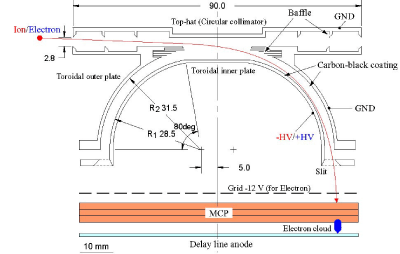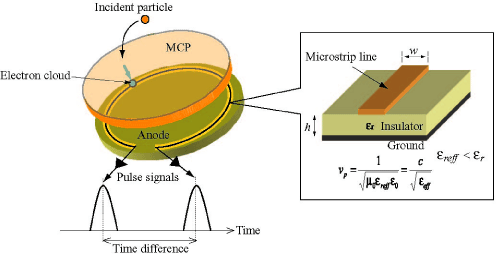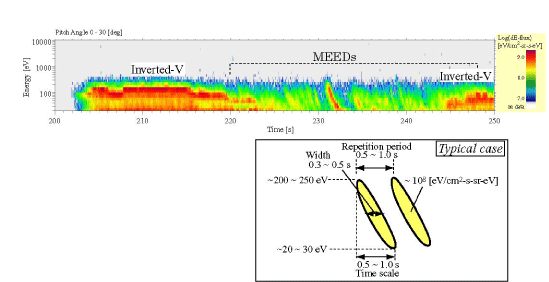wÊ_¶Xg - m_¶
| m_¶iv|j |
| Fine Structures of Field-Aligned Electron Acceleration in the Dayside@Cusp Region |
| Hiroki TANAKA |
|
This thesis deals with a study on field-aligned electron
acceleration observed in the dayside cusp region. The field-aligned electron acceleration is one of the
most interesting problems in space plasma physics.
Recent in-situ observations in the Earth's magnetosphere with a
high-time resolution instruments found highly structured ion and
electron precipitation in the cusp and
auroral region. These phenomena provide important clues to understand not
only the particle acceleration mechanism but also dynamic coupling between the magnetosphere and
the ionosphere. High-time resolution measurements are essential for investigating fine-scale electron acceleration in detail. We developed LEP-ESA/ISA (Low Energy Particle-Electron Spectrum Analyzer/Ion Spectrum Analyzer) which could analyze energy spectra of electrons and ions with a capability of the high-time resolution onboard the SS-520-2 sounding rocket. All science payloads onboard the rocket were required to have considerable high-time resolution (` 20 ms) for the purpose of this rocket experiment. Each of the ESA and ISA instruments consist of an energy analyzer and a position sensitive anode. A new type of the position sensitive anode called a delay line anode plays an important role for the high-time resolution measurements of low energy ions and electrons. This new technology is expected to take an active part in future space plasma missions. The SS-520-2 sounding rocket flew through the dayside mantle (or a high-latitude part of the cusp region) and LLBL in the vicinity of the cusp. The ESA/ISA simultaneously observed accelerated electrons and decelerated ions with the high-time resolution when the inverted V electron precipitation was observed. The energy correspondence between the electron acceleration and the ion deceleration clearly indicates the existence of the quasi-static field-aligned potential drop above the sounding rocket. Moreover, ion deceleration started 9.5 seconds later than the electron acceleration when convection flow velocity was low. By introducing a simple temporal model that a field-aligned potential drop gradually grew in 10 seconds at an altitude of about 4200 km, we successfully explain the observed characteristics of the electron acceleration and ion deceleration. The results of the fine-scale electron precipitation are also presented. Detailed characteristics of the electron precipitation, such as location, energy range, pitch angle distribution and scale size, are investigated by the electron data with high-time resolution. It is found that some characteristics are similar to those of previous studies. However, our observation shows several critical differences from previous results. There are at least two types of the electron precipitation, ``Edge type electron bursts (EEBs)'' and ``Multiple energy-time electron dispersions (MEEDs)''. EEB is observed only in the edge of the inverted V, whereas MEEDs are observed isolated from the inverted V and within or overlapping with the inverted V precipitation. Furthermore, source altitudes of MEEDs are estimated by both facts of the energy-time dispersion and the pitch angle-time dispersion, and it is found that source region distributes at altitudes of several thousands km along the geomagnetic field. We discuss the spatial and temporal models to know which is an effective mechanism for generating electron energy-time dispersions. It is indicated that a ``inertial Alfven wave (IAW)'' is the most realistic mechanism of the electron acceleration which can explain observational characteristics. IAWs propagate thorough the auroral altitudes with making the field-aligned electric field which is enough to accelerate ambient electrons at the altitudes of several thousand km. We constructed a one-dimensional test particle simulation of the IAW model. Simulation results demonstrate that the energy range, time scale, particle fluxes and source altitude are consistent with the observation. Moreover, it is revealed that magnetosheath electrons (`50 eV) injected through the cusp are accelerated by the resonance with IAWs. This acceleration process is important for understanding of the dynamic coupling between magnetosphere and ionosphere. |
 fig.1 Schematic diagram of LEP-ESA/ISA. Toroidal top-hat electrostatic analyzer. |
 fig.2 Schematic diagram of the delay line anode. The microstrip line is formed on the circle. The w and h are width of the strip line and thickness of the insulator. Ã_reff is effective dielectric constant. The characteristics of the microstrip line are decided by these parameters. |
 fig.3 Energy-time diagram of ESA between 200 s and 250 s after the rocket launch with the pitch angles within 30 degrees. The Differential energy flux [eV/cm^2-sr-s-eV] in logarismic scale is shown by color code. Multiple electron energy-time dispersions (MEEDs) are shown between the inverted-V type precipitations which shown at both the sides of the panel. In the edge of the inverted-V, several energy-time dispersions are confirmed. At 231 s, significant intense (the flux `10$^9 eV/cm^2 -sr-s-eV) energy-time dispersion is shown. The characteristics of typical case is summarized as shown below the E-t. |
< ÒW: º >